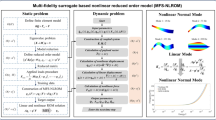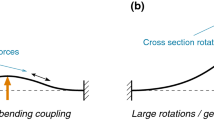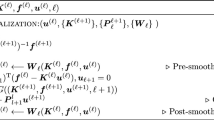Abstract
This work presents the application of a recently developed parametric, non-intrusive, and multi-fidelity reduced-order modeling method on high-dimensional displacement and stress fields arising from the structural analysis of geometries that differ in the size of discretization and structural topology. The proposed approach leverages manifold alignment to fuse inconsistent field outputs from high- and low-fidelity simulations by individually projecting their solution onto a common subspace. The effectiveness of the method is demonstrated on two multi-fidelity scenarios involving the structural analysis of a benchmark wing geometry. Results show that outputs from structural simulations using incompatible grids, or related yet different topologies, are easily combined into a single predictive model, thus eliminating the need for additional pre-processing of the data. The new multi-fidelity reduced-order model achieves a relatively higher predictive accuracy at a lower computational cost when compared to a single-fidelity model.

















Similar content being viewed by others
Code availability
The computer program that implements the method presented in this work will be made available through a repository link.
Notes
The geometry file of the baseline aircraft is provided as electronic supplementary material.
The AVL source code is publicly available at https://web.mit.edu/drela/Public/web/avl/.
The AVL model of the baseline aircraft is provided as electronic supplementary material.
The Nastran model of the baseline wing structure is provided as electronic supplementary material.
CPU times are based on an Intel Core i9-10885H CPU.
The field data generated with each fidelity level are provided as supplementary material.
References
Anderson GR, Aftosmis MJ, Nemec M (2012) Parametric deformation of discrete geometry for aerodynamic shape design. In: 50th AIAA aerospace sciences meeting including the new horizons forum and aerospace exposition (January), pp 1–18. https://doi.org/10.2514/6.2012-965
Bekemeyer P, Timme S (2019) Flexible aircraft gust encounter simulation using subspace projection model reduction. Aerosp Sci Technol 86:805–817. https://doi.org/10.1016/j.ast.2019.02.011
Benamara T, Breitkopf P, Lepot I, Sainvitu C (2016) Multi-fidelity extension to non-intrusive proper orthogonal decomposition based surrogates. In: Proceedings of the VII European congress on computational methods in applied sciences and engineering (ECCOMAS Congress 2016) (January 2016), pp 4129–4145. https://doi.org/10.7712/100016.2098.9174
Benamara T, Breitkopf P, Lepot I, Sainvitu C, Villon P (2017) Multi-fidelity POD surrogate-assisted optimization: concept and aero-design study. Struct Multidisc Optim 56(6):1387–1412. https://doi.org/10.1007/s00158-017-1730-4
Benaouali A, Kachel S (2019) Multidisciplinary design optimization of aircraft wing using commercial software integration. Aerosp Sci Technol 92:766–776. https://doi.org/10.1016/j.ast.2019.06.040
Bertram A, Othmer C, Zimmermann R (2018) Towards real-time vehicle aerodynamic design via multi-fidelity data-driven reduced order modeling. In: 2018 AIAA/ASCE/AHS/ASC structures, structural dynamics, and materials conference (January). https://doi.org/10.2514/6.2018-0916
Bhosekar A, Ierapetritou M (2018) Advances in surrogate based modeling, feasibility analysis, and optimization: a review. Comput Chem Eng 108:250–267. https://doi.org/10.1016/j.compchemeng.2017.09.017
Bordogna MT, Bettebghor D, Blondeau C, De Breuker R (2017) Surrogate-based aerodynamics for composite wing box sizing. In: 17th international forum aeroelasticity structure dynamics
Braconnier T, Ferrier M, Jouhaud JC, Montagnac M, Sagaut P (2011) Towards an adaptive POD/SVD surrogate model for aeronautic design. Comput Fluids 40(1):195–209. https://doi.org/10.1016/j.compfluid.2010.09.002
Cipolla V, Salem KA, Palaia G, Binante V, Zanetti D (2021) A DoE-based approach for the implementation of structural surrogate models in the early stage design of box-wing aircraft. In: Aerospace science and technology, p 106968. https://doi.org/10.1016/j.ast.2021.106968
De Bie T, Cristianini N, Rosipal R (2005) Eigenproblems in pattern recognition. Handb Geom Comput 10:129–167
Decker K, Iyengar N, Perron C, Rajaram D, Mavris D (2021) Nonlinear Multi-Fidelity Reduced Order Modeling Method using Manifold Alignment. In: AIAA AVIATION 2021 FORUM. Reston, Virginia: American Institute of Aeronautics and Astronautics, pp 1–25. https://doi.org/10.2514/6.2021-3050
Duca R, Sarojini D, Bloemer S, Chakraborty I, Briceno SI, Mavris DN (2018) Effects of epistemic uncertainty on empennage loads during dynamic maneuvers. In: 2018 AIAA aerospace sciences meeting, p 0767. https://doi.org/10.2514/6.2018-0767
Forrester AIJ, Keane AJ (2009) Recent advances in surrogate-based optimization. Prog Aerosp Sci 45(1–3):50–79. https://doi.org/10.1016/j.paerosci.2008.11.001
Forrester AIJ, Sóbester A, Keane AJ (2007) Multi-fidelity optimization via surrogate modelling. Proc R Soc A 463(2088):3251–3269. https://doi.org/10.1098/rspa.2007.1900
Gower JC (2010) Procrustes methods. Wiley Interdiscip Rev 2(4):503–508. https://doi.org/10.1002/wics.107
Ham J, Lee DD, Saul LK (2005) Semisupervised alignment of manifolds. In: Proceedings of the tenth international workshop on artificial intelligence and statistics, vol 10, pp 120–127
Han ZH, Görtz S (2012) Hierarchical kriging model for variable-fidelity surrogate modeling. AIAA J 50(9):1885–1896. https://doi.org/10.2514/1.J051354
Kennedy GJ, Martins JR (2014) A parallel aerostructural optimization framework for aircraft design studies. Struct Multidisc Optim 50(6):1079–1101. https://doi.org/10.1007/s00158-014-1108-9
Kennedy MC, O’Hagan A (2000) Predicting the output from a complex computer code when fast approximations are available. Biometrika 87(1):1–13. https://doi.org/10.1093/biomet/87.1.1
Kenway G, Kennedy G, Martins J (2010) A CAD-free approach to high-fidelity aerostructural optimization. In: 13th AIAA/ISSMO multidisciplinary analysis optimization conference. Reston, Virigina: American Institute of Aeronautics and Astronautics, pp 1–18
Koo D, Zingg DW (2016) Progress in aerodynamic shape optimization based on the reynolds-averaged Navier–Stokes equations. In: 54th AIAA aerospace sciences meeting. January. American Institute of Aeronautics and Astronautics, Reston, Virginia, pp 1–24
Li X, Gong C, Gu L, Jing Z, Fang H, Gao R (2019) A reliability-based optimization method using sequential surrogate model and Monte Carlo simulation. Struct Multidisc Optim 59(2):439–460. https://doi.org/10.1007/s00158-018-2075-3
Liang YC, Lee HP, Lim SP, Lin WZ, Lee KH, Wu CG (2002) Proper orthogonal decomposition and its applications—part I: theory. J Sound Vib 252(3):527–544. https://doi.org/10.1006/jsvi.2001.4041
Lieu T, Farhat C (2007) Adaptation of aeroelastic reduced-order models and application to an F-16 configuration. AIAA J 45(6):1244–1257. https://doi.org/10.2514/1.24512
Lieu T, Farhat C, Lesoinne M (2006) Reduced-order fluid/structure modeling of a complete aircraft configuration. Comput Methods Appl Mech Eng 195(41–43):5730–5742. https://doi.org/10.1016/j.cma.2005.08.026
Lu K, Jin Y, Chen Y, Yang Y, Hou L, Zhang Z, Li Z, Fu C (2019) Review for order reduction based on proper orthogonal decomposition and outlooks of applications in mechanical systems. Mech Syst Signal Process 123:264–297. https://doi.org/10.1016/j.ymssp.2019.01.018
Lumley JL (1967) The Structure of inhomogeneous turbulent flows. In: Yaglom AM, Tatarski VI (eds) Atmospheric turbulence and radio propagation. Nauka, Moscow, pp 166–178
Lyu Z, Kenway GK, Martins J (2014) RANS-based aerodynamic shape optimization investigations of the common research model wing. In: 52nd aerospace sciences meeting, vol 2014, No 4, pp 1–19. https://doi.org/10.2514/6.2014-0567
Mainini L, Willcox K (2015) Surrogate modeling approach to support real-time structural assessment and decision making. AIAA J 53(6):1612–1626. https://doi.org/10.2514/1.J053464
Malouin B, Trépanier JY, Gariépy M (2013) Interpolation of transonic flows using a proper orthogonal decomposition method. Int J Aerosp Eng 2013:1–11. https://doi.org/10.1155/2013/928904
Mifsud M (2008) Reduced-order modelling for high-speed aerial weapon aerodynamics (Ph.D. Thesis). Cranfield University. http://hdl.handle.net/1826/3511
Mifsud MJ, MacManus DG, Shaw ST (2016) A variable-fidelity aerodynamic model using proper orthogonal decomposition. Int J Numer Meth Fluids 82(10):646–663. https://doi.org/10.1002/fld.4234
Mohamed K, Sermeus K, Laurendeau E (2010) A fast grid deformation algorithm for aerodynamic shape optimization. Proceedings of the ASME design engineering technical conference. 1(PARTS A AND B):487–495. https://doi.org/10.1115/DETC2010-28782
Neufeld D, Behdinan K, Chung J (2010) Aircraft wing box optimization considering uncertainty in surrogate models. Struct Multidisc Optim 42(5):745–753. https://doi.org/10.1007/s00158-010-0532-8
PACE Cluster Participation (2020) https://pace.gatech.edu/participation
Perron C (2020) Multi-fidelity reduced-order modeling applied to fields with inconsistent representations (Ph.D. Thesis). Georgia Institute of Technology
Perron C, Rajaram D, Mavris D (2020) Development of a multi-fidelity reduced-order model based on manifold alignment. In: AIAA AVIATION 2020 FORUM, p 3124. https://doi.org/10.2514/6.2020-3124
Perron C, Rajaram D, Mavris DN (2021) Multi-fidelity non-intrusive reduced-order modelling based on manifold alignment. Proc R Soc A 477(2253):20210495. https://doi.org/10.1098/rspa.2021.0495
Pinnau R (2008) Model reduction via proper orthogonal decomposition. In: Model order reduction: theory, research aspects and applications. Springer, Berlin, pp 95–109
Quarteroni A, Manzoni A, Negri F (2016) Reduced basis methods for partial differential equations. In: UNITEXT, vol 92. Springer International Publishing, Cham
Queipo NV, Haftka RT, Shyy W, Goel T, Vaidyanathan R, Kevin TP (2005) Surrogate-based analysis and optimization. Prog Aerosp Sci 41(1):1–28. https://doi.org/10.1016/J.PAEROSCI.2005.02.001
Rasmussen C, Canfield R, Blair M (2009) Optimization process for configuration of flexible joined-wing. Struct Multidisc Optim 37(3):265. https://doi.org/10.1007/s00158-008-0229-4
Ripepi M, Verveld MJ, Karcher N, Franz T, Abu-Zurayk M, Görtz S, Kier TM (2018) Reduced-order models for aerodynamic applications, loads and MDO. CEAS Aeronaut J 9(1):171–193. https://doi.org/10.1007/s13272-018-0283-6
Santner TJ, Williams BJ, Notz WI (2003) Space-filling designs for computer experiments. In: The design and analysis of computer experiments, pp 121–161. Springer, New York
Sarojini D, Xie J, Cai Y, Corman JA, Mavris D (2020) A certification-driven platform for multidisciplinary design space exploration in airframe early preliminary design. In: AIAA AVIATION 2020 FORUM, p 3157. https://doi.org/10.2514/6.2020-3157
Toal DJJ (2015) Some considerations regarding the use of multi-fidelity Kriging in the construction of surrogate models. Struct Multidisc Optim 51(6):1223–1245. https://doi.org/10.1007/s00158-014-1209-5
Vassberg J, Dehaan M, Rivers M, Wahls R (2008) Development of a common research model for applied CFD validation studies. In: 26th AIAA applied aerodynamics conference, p 6919
Vendl A, Faßbender H (2013) Projection-based model order reduction for steady aerodynamics. In: Kroll N, Radespiel R, Burg JW, Sørensen K (eds) Computational flight testing: results of the closing symposium of the German research initiative ComFliTe, Braunschweig, Germany, June 11th–12th, 2012. Springer, Berlin, pp 151–166
Wang C, Mahadevan S (2009) A general framework for manifold alignment. In: AAAI fall symposium series, pp 53–58
Yondo R, Andrés E, Valero E (2018) A review on design of experiments and surrogate models in aircraft real-time and many-query aerodynamic analyses. Prog Aerosp Sci 96(November 2017):23–61. https://doi.org/10.1016/j.paerosci.2017.11.003
Zhang W, Wang B, Ye Z, Quan J (2012) Efficient method for limit cycle flutter analysis based on nonlinear aerodynamic reduced-order models. AIAA J 50(5):1019–1028. https://doi.org/10.2514/1.J050581
Funding
No funding, grants, or other monetary support was received.
Author information
Authors and Affiliations
Corresponding author
Ethics declarations
Conflict of interest
The authors declare that there is no conflict of interest.
Replication of Results
The data and accompanying material used to generate results presented in this work will be made available as electronic supplementary material.
Additional information
Responsible Editor: Yoojeong Noh
Publisher's Note
Springer Nature remains neutral with regard to jurisdictional claims in published maps and institutional affiliations.
Topical Collection: 14th World Congress of Structural and Multidisciplinary Optimization
Guest Editors: Y Noh, E Acar, J Carstensen, J Guest, J Norato, P Ramu
Supplementary Information
Below is the link to the electronic supplementary material.
Rights and permissions
Springer Nature or its licensor holds exclusive rights to this article under a publishing agreement with the author(s) or other rightsholder(s); author self-archiving of the accepted manuscript version of this article is solely governed by the terms of such publishing agreement and applicable law.
About this article
Cite this article
Perron, C., Sarojini, D., Rajaram, D. et al. Manifold alignment-based multi-fidelity reduced-order modeling applied to structural analysis. Struct Multidisc Optim 65, 236 (2022). https://doi.org/10.1007/s00158-022-03274-1
Received:
Revised:
Accepted:
Published:
DOI: https://doi.org/10.1007/s00158-022-03274-1




